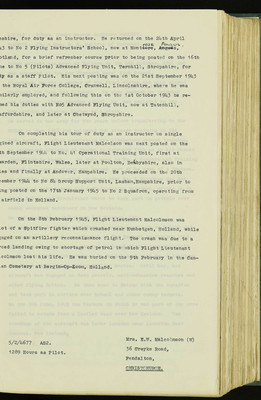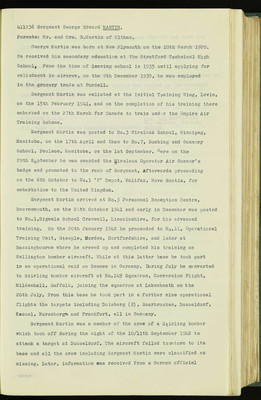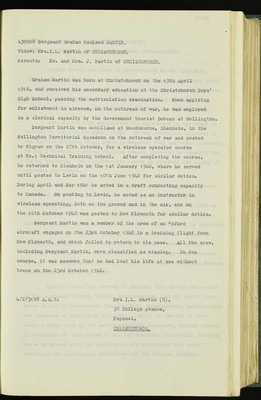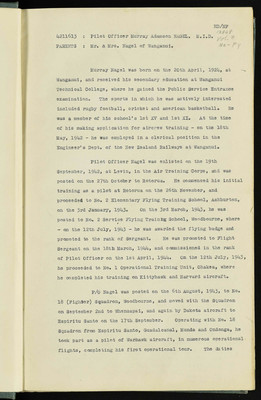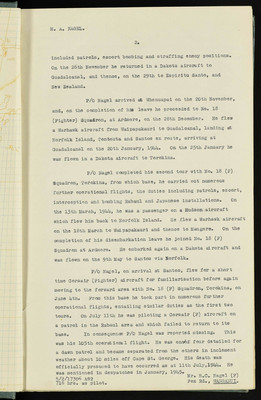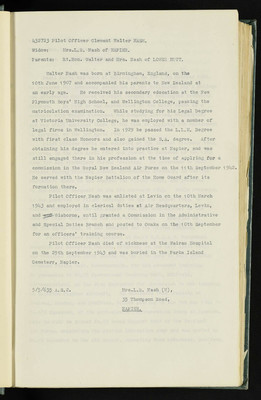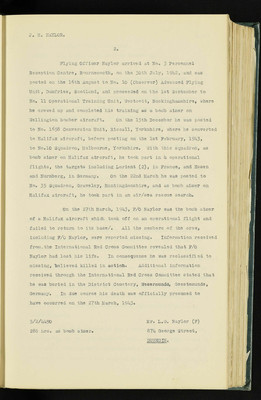Pages That Need Review
RNZAF Biographies of Deceased Personnel: 1939 - 1945, Ma - McW
20
2522 Flying Officer Harry Naider Major. Mother: Mrs. M. Osmond of Christchurch.
Harry Major was born at Auckland on the 30th October, 1910, and received his secondary education at King's College, Auckland, reach-ing Matriculation standard. He played for his school 1st XI, and later playing golf. After leaving school, he was engaged in sheep farming at Lake Tekapo, Canterbury. He obtained his "A" License in 1930 and was appointed to a Commission in the New Zealand Air Force in the rank of Pilot Office on the 19th September, 1932, and posted to No. 4 Squadron.
Pilot Officer Major continued to carry out the annual prescribed training and was promoted to the rank of Flying Officer on the 2nd April, 1935, continuing to serve until the outbreak of war, when he was mobilised at Whenuapai with the Auckland General Reconnaisance Squadron. He was posted to Ohaken for duty as a Staff Pilot on the 17th November, 1939.
Flying Officer Major was the pilot of an Oxford aircraft engag-ed on the 19th October, 1940 in a fight from Hobsonville to Ohakes. The aircraft failed to arrive at its destination and Flying Officer Major was classified as missing. Several months later, the wrecked aircraft was forund in dense bush near the West Coast north of Mokau, and the bodies of the crew were found nearby,
Flying Officer was cremated at Auckland.
4/3/177 A.S.2. No log book.
Mrs M. Osmond (M), 249 Gloucester Street, CHRISTCHURCH.
24
Cheshire, for duty as an instructor. He returned on the 24th April 1943, to No. 2 Flying Instructors' School now at Montrose, Angus, Scotland, for a brief refresher course prior to being posted on the 16th (unreadable) to No 5 (Pilots) Advanced Flying Unit, Ternhill, Shropshire, for (unreadable) as staff Pilot. His next posting was on the 21st September 1943 (missing) the Royal Air Force College, Cranwell, Lincolnshire, whre he was similiarly employed, and following this on the 1st October 1943 he re(missing) his duties with No. 5 Advanced Flying Unit, now at Tatenhill, Staffordshire, and later at Chetwynd, Shropshire.
On completing his tour of duty as an instructor on single (missing) aircraft. Flight Lieutenant Malcolson was next posted on the (missing) September, 1944 to No. 41 Operational Training Unit, first at (missing) warden, Flintshire, Wales, later at Poulton, Derbyshire, also in (missing) and finally at Andover, Hampshire. He proceeded on the 20th (missing) 1944 to No. 84 Group Support Unit, Lasham, Hampshire, prior to (missing) posted on the 17th January 1945 to No. 2 Squadron, operating from (missing) airfield to Holland.
On the 8th February 1945, Flight Lieutenant Malcolmson was (missing) of a Spitfire fighter which crashed near Hunbetgen, Holland, while (missing) on an artillery reconnaissance flight. The crash was due to a (missing) landing owing to shortage of petrol in which Flight Lieutenant (missing) lost his life. He was buried on the 9th February in the Can-(missing) Cemetery at Bergin-Op-Zoom, Holland.
5/2/4677 AS2 1289 Hours as Pilot.
Mrs. E.W. Malcolmson (W) (right aligned) 36 Creyke Road, (right aligned) Fendalton, (right aligned) CHRISTCHURCH. (right aligned & underlined)
104
411236 Sergeant Geroge Edward MARTIN. Parents: Mr. and Mrs. B.Martin of Eltham.
George Martin was born at New Plymouth on the 10th March 1920. He received his secondary education at the Stratford Technical High School. From the time of leaving school in 1935 until applying for enlistment in aircrew, on the 9th December 1939, he was employed in the grocery trade at Fordell.
Sergeant Martin was enlisted at the Initial Training Wing, Levin, on the 15th February 1941, and on the completion of his training there embarked on the 27th March for Canada to train under the Empire Air Training Scheme.
Sergeant Martin was posted to No.3 Wireless School, Winnipeg, Manitoba, on the 17th April and then to No.7, Bombing and Gunnery School, Paulson, Manitoba, on the 1st September. Here on the 29th September he was awarded the Wireless Operator Air Gunner's badge and promoted to the rank of Sergeant. Afterwards proceeding on the 6th October to No.1 'Y' Depot, Halifax, Nova Scotia, for embarkation to the United Kingdom.
Sergeant Martin arrived at No.3 Personnel Reception Centre, Bournemouth, on the 24th October 1941 and early in December was posted to No.1 Signals School Cranwell, Lincolnshire, for his advanced training. On the 20th January 1942 he proceeded to No.11, Operational Training Unit, Steeple, Morden, Hertfordshire, and later at Bassingbourne where he crewed up and completed his training on Wellington bomber aircraft. While at this later base he took part in an operational raid on Bremen in Germany. During July he converted to Stirling bomber aircraft at No.149 Squadron, Conversion Flight, Mildenhall, Suffolk, joining the squadron at Lakenheath on the 20th July. From this base he took part in a further nine operational flights the targets including Duisberg (2), Saarbrucken, Dusseldorf, Kassel, Nurenberg and Frankfurt, all in Germany.
Sergeant Martin was a member of the crew of a Stirling bomber which took off during the night of the 10/11th September 1942 to attack a target at Dusseldorf. The aircraft failed to return to its base and all the crew including Sergeant Martin were classified as missing. Later, information was received from a German offical
106
439008 Sergeant Graham MacLeod MARTIN. Widow: Mrs. I.L. Martin of CHRISTCHURCH. Parents: Mr. and Mrs. J. Martin of CHRISTCHURCH.
Graham Martin was born at Christchurch on the 13th April 1916, and received his secondary education at the Christchurch Boys' High School, passing the matriculation examination. When applying for enlistment in aircrew, on the outbreak of war, he was employed in a clerical capacity by the Government Tourist Bureau at Wellington.
Sergeant Martin was mobilised at Woodbourne, Blenheim, in the Wellington Territorial Squadron on the outbreak of war and posted to Wigram on the 27th October, for a wireless operator course at No.1 Technical Training School. After completing the course, he returned to Blenheim on the 1st January 1940, where he served until posted to Levin on the 10th June 1942 for similar duties.
During April and May 1941 he acted in a draft conducting capacity to Canada. On posting to Levin, he acted as an instructor in wireless operating, both on the ground and in the air, and on the 16th October 1942 was posted to New Plymouth for similar duties.
Sergeant Martin was a member of the crew of an Oxford aircraft engaged on the 23rd October 1942 in a training flight from New Plymouth, and which failed to return to its base. All the crew, including Sergeant Martin, were classified as missing. In due course, it was assumed that he had lost his life at sea without trace on the 23rd October 1942.
4/2/3198 A.S.2
Mrs. I.L. Martin (W), 30 College Avenue, Papanui, CHRISTCHURCH.
RNZAF Biographies of Deceased Personnel: 1939 - 1945, Na - Py
1
HD/NF 12848 Vol. 8 NA-PY
4211613: Pilot Officer Murray Adamson NAGEL. M.I.D. PARENTS: Mr. & Mrs. Nagel of Wanganui.
Murray Nagel was born on the 20th April, 1924, at Wanganui, and received his secondary education at Wanganui Technical College, where he gained this Public Service Entrance examination. The sports in which he was actively interested included rugby football, cricket and american basketball. He was a member of his school's 1st XV and 1st XI. At the time of his making application for aircrew training - on the 18th May, 1942 - he was employed in a clerical position in the Engineer's Dept. of the New Zealand Railways at Wanganui.
Pilot Officer Nagel was enlisted on the 19th September, 1942, at Levin, in the Air Training Corps, and was posted on the 27th October to Rotorua. He commenced his initial training as a pilot at Rotorua on the 26th November, and proceeded to No. 2 Elementary Flying Training School, Ashburton, on the 3rd January, 1943. On the 3rd March, 1943, he was posted to No. 2 Service Flying Training School, Woodbourne, where - on the 12th July, 1943 - he was awarded the flying badge and promoted to the rank of Sergeant. He was promoted to Flight Sergeant on the 18th March, 1944, and commissioned in the rank of Pilot Officer on the 1st April, 1944. On the 12th July, 1943, he proceeded to No. 1 Operational Training Unit, Ohakea, where he completed his training on Kittyhawk and Harvard aircraft.
P/O Nagel was posted on the 6th August, 1943, to No. 18 (Fighter) Squadron, Woodbourne, and moved with the Squadron on September 2nd to Whenuapai, and again by Dakota aircraft to Espiritu Santo on the 17th September. Operating with No. 18 Squadron from Espiritu Santo, Guadalcanal, Munda and Ondonga, he took part as a pilot of Warhawk aircraft, in numerous operational flights, completing his first operational tour. The duties
2
M. A. NAGEL.
2.
included patrols, escort bombing and straffing enemy positions. On the 26th November he returned in a Dakota aircraft to Guadalcanal, and thence, on the 29th to Espiritu Santo, and New Zealand.
P/O Nagel arrived at Whenuapai on the 20th November, and, on the completion of his leave he proceeded to No. 18 (Fighter) Squadron, at Ardmore, on the 28th December. He flew a Warhawk aircraft from Waipapakauri to Guadalcanal, landing at Norfolk Island, Tontouta and Santos en route, arriving at Guadalcanal on the 20th January, 1944. On the 25th January he was flown in a Dakota aircraft to Torokina.
P/O Nagel completed his second tour with No. 18 (F) Squadron, Torokina, from which base, he carried out numerout further operational flights, the duties including patrols, escort, interception and bombing Rabaul and Japanese installations. On the 13th March, 1944, he was a passenger on a Hudson aircraft which flew him back to Norfolk Island. He flew a Warhawk aircraft on the 18th March to Waipapakauri and thence to Mangere. On the completion of his disembarkation leave he joined No. 18 (F) Squadron at Ardmore. He embarked again on a Dakota aircraft and was flown on the 9th May to Santos via Norfolk.
P/O Nagel, on arrival at Santos, flew for a short time Corsair (Fighter) aircraft for familiarisation before again moving to the forward area with No. 18 (F) Squadron, Torokina, on June 4th. From this base he took part in numerous further operational flights, entailing similar duties as the first two tours. On July 11th he was piloting a Corsair (F) aircraft on a patrol in the Rabaul area and which failed to return to its base. In consquence P/O Nagel was reported missing. This was his 105th operational flight. He was one of four detailed for a dawn patrol and became separated from the others in inclement weather about 10 miles off Cape St. George. His death was officially presumed to have occured as at 11th July, 1944. He was mentioned in dispatches in January, 1945.
5/2/17306 AS2 716 hrs. as pilot.
Mr. H.C. Nagel (F) Fox Rd., WANGANUI.
3
NZ42117 Pilot Officer Colin George NAIRNE. Widow Mrs. R.O. Nairne, R.M.D., Richmond, Nelson. Parents Mr. and Mrs. W.J. Nairne, Kaiwarra, Wellington.
Colin Nairne was born at Palmerston North on the 8th April 1922, and received his secondary education at the Taihape Dis-trict High School. While at school he played Rugby, football for the First Fifteen, and also took part in cricket and swimming. Prior to joining the Royal New Zealand Air Force, he was employed on the Studholme Estate, Hihitabi, farming and tractor driving.
Pilot Officer Nairne made application for aircrew trainnig in the Royal New Zealand Air Force, on the 26th December 1940, and was enlisted at Blenheim on the 12th January 1942, where he was employed on ground duties until proceeding to the Initial Training Wing, Rotours for aircrew training on 3rd September.
On completion of his intial training he was poster to No 3 Elementary Flying Training School, Harewood, on the 15th October, and on the 29th December to No 1 Service Flying Training School, Wigram, where on the 15th March 1943 he was awarded the flying badge and promoted to Sergeant, on the 6th May. He embarked for the United Kingdom via Canada on the 20th May 1943.
On arrival in England on the 8th July 1943, Pilot Officer Nairne was posted to No 12 Personnel Reception Centre, Brighton, and proceeded to No 14 (Pilots) Advanced Flying Unit, Dell-achy, Scotland on the 3rd August. Here he trained until mid November, when he was posted to No 11 Operational Training Unit, Royal Air Force, Oakley for operational training on Wellington bomber aircraft. On the 3rd March 1944 he was posted to No 1657 Conversion Unit, Stradis-hall, Suffolk, where he trained on Stirling aircraft, until proceed-ing on the 29th May to No 75 (New Zealand) Squadron, Nepal, Cambridge, from which base he carried out 20 operational flights. The targets on these raids included Calais, Lisieux, Dreux, Nantes, Le Harve, Valen-ciennes, Montdidier, Villiersbocage, Watten, and Vaires (4) Bois Desjardines andd Cagny in France, and Homburg (2), Keil, and Stuttgart in Germany.
5
432723 Pilot Officer Clement Walter NASH. Widow: Mrs. L.R. Nash of NAPIER. Parents: Rt.Hon. Walter and Mrs. Nash of LOWER HUTT
Walter Nash was born at Birmingham, England, on the 10th June 1907 and accompanied his parents to New Zealand at an early age. He received his secondary education at the New Plymouth Boys' High School, and Wellington College, passing the matriculation examination. While studying for his Legal Degree at Victoria University College, he was employed with a number of legal firms in Wellington. In 1929 he passed the L.L.M. Degree with first class Honours and also gained the B.A. degree. After obtaining his degree he entered into practice at Napier, and was still engaged there in his profession at the time of applying for a commission in the Royal New Zealand Air Force on the 11th September 1942. He served with the Napier Battalion of the Home Guard after its formation there.
Pilot Officer Nash was enlisted at Levin on the 10th March 1943 and employed in clerical duties at Air Headquarters, Levin, and Gisborne, until granted a Commission in the Administrative and Special Duties Branch and posted to Omaka on the 10th September for an officers' training course.
Pilot Officer Nash died of sickness at the Wairau Hospital on the 29th September 1943 and was buried in the Parke Island Cemetery, Napier.
5/5/635 A.S.2
Mrs.L.R. Nash (W), 35 Thompson Road, NAPIER.
10
J. H. NAYLOR
2.
Flying Officer Naylor arrived at No. 3 Personnel Reception Centre, Bournemouth, on the 30th July, 1942, and was posted on the 16th August to No. 10 (Observer) Advanced Flying Unit, Dumfries, Scotland, and proceeded on the 1st September to No. 11 Operational Training Unit, Westcott, Buckinghamshire, where he crewed up and completed his training as a bomb aimer on Wellington bomber aircraft. On the 15th December he was posted to No. 1658 Conversion Unit, Riccall, Yorkshire, where he converted to Halifax aircraft, befor posting on the 1st February, 1943, to No. 10 Squadron, Melbourne, Yorkshire. With this squadron, as bomb aimer on Halifax aircraft, he took part in 4 operational flights, the targets including Lorient (2), in France, and Essen and Nurnberg, in Germany. On the 22nd March he was posted to No. 35 Squadron, Graveley, Huntingtonshire, and as a bomb aimer on Halifax aircraft, he took part in an air/sea rescue search.
On the 27th March, 1943, F/O Naylor was the bomb aimer of a Halifax aircraft which took off on an operational flight and failed to return to its base/. All the members of the crew, including F/O Naylor, were reported missing. Information received from the International Red Cross Committee revealed that F/O Naylor had lost his life. In consequence he was reclassified to missing, believed killed in action. Additional information received through the International Red Cross Committee stated that he was buried in the District Cemetery, Wesermunde, Geestemunde, Germany. In due course his death was officially presumed to have occurred on the 27th March, 1943.
5/2/4490 288 hrs. as bomb aimer.
Mr. L.G. Naylor (F) 874 George Street, DUNEDIN.
14
Scotland, afterwards proceeding on the 24th August to No 15 Operatio-nal Training Unit, Harwell, Berkshire, where he trained on Wellington bomber aircraft. Early in January 1944, he converted to Halifax air-craft at No 1663 Conversion Unit, Rufforth, Yorkshire, and then pro-ceeded to No 301 Perry Training Unit, Lyneham, Wiltshire, for embark-ation oversea. On the 21st February as Navigator of a Halifax air-craft he flew to Rabat Sale in Algeria, and on the 8th March to Blida, where he was posted to No 624 Squadron. From this base as Navigator of Halifax aircraft he took part in thirty three operational flights mainly supply dropping to the South of France, and including one trip to Italy from Maison Blanche.
Flying Officer Neale was the Navigator of a Halifax aircraft engaged on a supply dropping operation to the south of France on the night of the 13/14th August 1944. The aircraft failed to return to its base and all the crew including Flying Officer Neale were classified as missing. In due course his death was officially presumed to have occurred on the 14th August 1944.
A post war casualty search revealed that an uniden-tified aircraft was seen to explode and dive into the sea between Palamos and Cape Efos, but no trace was found of either the aircraft or any of the crew, and it is assumed that Flying Officer Neale lost his life at sea.
5/2/14106 AS2. 523 Hours as Navigator.
Mrs. G.G. Neale. (W) 13 Marau Crescent, MISSION BAY, AUCKLAND.

